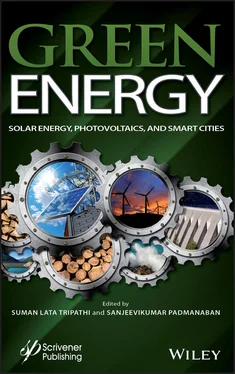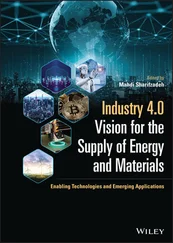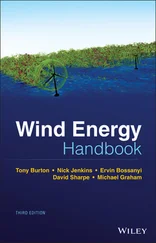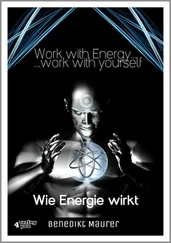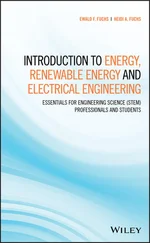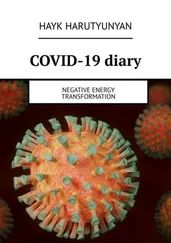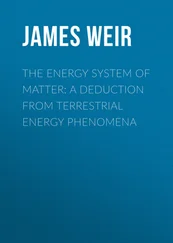This book is organized into 20 chapters.
Chapter 1discusses the crystalline silicon solar cell (c-Si)–based technology that has been recognized as the environment-friendly viable solution to replace traditional energy sources for power generation. The chapter mainly elaborates the three basic c-Si solar cell configurations that are monofacial, bifacial and back-contacted solar cell configurations.
Chapter 2is mainly focused on p-type mono-Si-PERC and n-type c-Si based TOPCon solar cell with enhanced efficiency. The use of HJ-TF cells, the Cu 2O, InGaN, CuInS 2, and InP fabrics are also explored for solar cell developments.
Chapter 3summarizes the recent advancement made in the fabrication and manufacturing process for commercialization of PSC in the photovoltaic (PV) market and also various possible techniques used to improve their physical properties, and overcome hurdles and challenges while fabricating perovskite films.
Chapter 4presents a short yet comprehensive survey on the metaheuristic approaches to the parameter assessment of solar photovoltaic systems modelled by different diode models.
Chapter 5describes the review and challenge in solar PV cell design and implementation. Furthermore, it outlines the existing PV systems, the structure of different PV panels, MPPT, and the solid-state converter topologies.
Chapter 6compares the developed method with its traditional counterpart, and the results of the experiment show that the new model performs better in terms of computational efficiency, compression gain, and SOH estimation accuracy.
Chapter 7presents a detailed discussion on power quality (PQ) disturbances that cause rigorous issues in smart grids and industries. This mainly covers event-driven processing, analysis and machine learning for successful and efficient detection of PQ disturbances.
Chapter 8is intended to provide information about the structural, optical, dielectric and conductivity with the help of compositional modification at Sr-site of Sr 2SnO 4by homovalent (Ba 2 +) and hetrovalent (La 3 +).
Chapter 9focuses on the detailed modelling of a solar photovoltaic (PV) panel. Here, a single-diode four-parameter model is also described that can be used for all panels in general.
Chapter 10explores a stepped DC link converter for solar power that is focused for configurations of BCMLI, CDCLHBI and BCDCLHBI and synthesizing seven-level AC power output.
Chapter 11derived a new modified double-diode model equation and on the basis of that formed a new objective function for MDDM. The HHO algorithm was used to estimate all the eight parameters of the system for different types of commercially available PV modules.
Chapter 12describes a switched-inductor switched-capacitor-based large-gain DC-DC converter with low voltage stress on its switches/diodes.
Chapter 13envisages presenting the stability concerns and issues associated with microgrids along with a state-of-the-art review of the techniques employed for improving stability of microgrids working in either islanded or grid-connected mode.
Chapter 14deals with three-phase current ripples, and also the torque ripple of a surface-mounted permanent magnet synchronous motor (SPMSM) was completely analysed and minimized based on the variable switching frequency PWM (VSFPWM) method.
Chapter 15discuss the implementation of Internet of Things (IoT) in the Smart Home, which plays a major role in making the things automatic and also saves a lot of energy.
Chapter 16deals with the assessment of the economic and environmental impacts of energy conservation strategies in a university campus.
Chapter 17suggests a novel double-source basic unit for cascaded MLIs that can produce seven output voltage steps with Trinary magnitude of DC supplies. The suggested structure can operate as symmetric or asymmetric MLI.
Chapter 18presents the designing procedure of conventional and the vector control, Proportional Integral (PI) controller and analyzes the performance characteristics of DFIG connected to the Grid Systems.
Chapter 19describes the combination of conventional SEPIC and quadratic boost converters with a boosting stage, which increases the boosting factor of converter. The continuous input-current as well as large boosting capability make the proposed topology applicable for Photovoltaic (PV) applications.
Chapter 20proposes two novel basic configurations for switched-capacitor-based 13- and 17-level inverters, with high step-up capability and self-voltage balancing of capacitors.
1
Fabrication and Manufacturing Process of Solar Cell: Part I
S. Dwivedi
S.S. Jain Subodh P.G. (Autonomous) College, Jaipur, India
Abstract
Crystalline silicon solar cell (c-Si) based technology has been recognized as the only environment-friendly viable solution to replace traditional energy sources for power generation. It is a cost-effective, renewable and long-term sustainable energy source. The Si-based technology has a market growth of almost 20-30% and is projected to attain an energy share of ~100 giga watt (GW) per year in the current fiscal year, 2020. There have been constant efforts in reducing manufacturing cost of solar panel technology, which is about three-four times higher in comparison to traditional carbon-based fuels. In the manufacturing domain, fabrication of three basic c-Si solar cell configurations can be utilized, which are differentiated in the manner of generation of electron-hole (E-H) pairs on exposure to sunlight. The generation of electricity by impinging light on a semiconductor material requires production of electrons and holes such that electrons in the valence band become free and jump to the conduction band by absorbing energy. Thus, jumping of highly energetic electrons to different material generates an electromotive force (EMF) converting light energy into electrical signals. This is known as the photovoltaic (PV) effect.
This chapter is an effort to outline fabrication processes and manufacturing methodologies for commercial production of large area PV modules as an alternative green source of energy.
Keywords:Solar cell, photovoltaics, p-n junction, photovoltaic panels, crystalline silicon solar cell, renewable energy, physics of solar cell, fabrication of solar cell
There has always been a surge to discover newer sources of energy which can be effective alternatives for the orthodox sources of energy, such as, petrol, kerosene, wind energy, thermal power generators [1,2]. In this quest, the sun is a natural huge source of renewable green energy. It is noteworthy that the terrestrial soil is exposed to an enormous amount of solar energy as large as about ten thousand times of all the energy used around the globe. The terrestrial hemisphere facing the sun receives power in excess of 50,000 terawatt (TW) in each instance, which makes reception of an enormous amount of energy possible [3]. Photovoltaics (PV) technology is a technology that relies on this infinite source of sunlight and possesses inherent qualities of highly reduced service costs since the sun provides free energy, reliability, noiseless, minimum maintenance costs and readily installation features [4, 5].
As a matter of fact, thermonuclear fusion reactions happen non-stop at a temperature of millions of degrees to generate huge energy in the form of electromagnetic radiation of sunlight [5,6]. The outer layer of the earth’s atmosphere receives partial energy of the total energy from the sun with a solar constant or an average irradiance of approximately 1367 Wm -2with a variation of ±3% [8]. This value of solar constant is dependent on the earth-to-sun distance and on the solar activity. The solar constant is defined as the intensity of solar electromagnetic radiation impinging on a unit surface area and is expressed in units of kWm -2and is equal to the integral of the power of the individual frequencies in the spectrum of solar radiation. The geometry of the sun-to-earth distance is displayed in Figure 1.1given below.
Читать дальше
